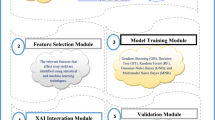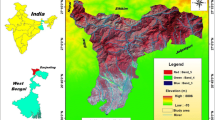Abstract
Climate change has noticeable significant impacts on development of most countries because of its direct negative effect on the production and revenue of most crops plantation process. In reality, the ongoing changes in climate variables affect the suitability of planting some crops in their traditional places at their traditional dates. Furthermore, the availability of huge volumes of agro-climatic data that almost incorporates uncertainty increases the complexity of managing and discovering the crops suitable plantation patterns from such data. Accordingly, a need appeared to an efficient approach to handle such uncertainty and to exploit such huge data volume to manage the crops plantation process accurately. This paper presents a fuzzy approach based on Hadoop for discovering crops plantation knowledge from the agro-climatic historical database of the years from 1983 to 2016 of Egypt. Commonly, the proposed approach provides a set of scenarios for plantation dates of each crop with a suitability degree for each scenario. Also, it helps managing crops plantation process from some other aspects such as harvesting dates, candidate diseases and follow up for crops water requirements respecting the data streaming of the prevailing weather data. The proposed approach has been tested on a set of crops with cooperation of researchers from Cairo University and Agricultural Research Center. The results show the added value of the proposed approach against other works respecting the more suitable crops plantation dates, harvesting dates, expected diseases and follow up for crops water requirements. Furthermore, the proposed approach benefits from Hadoop framework capabilities of handling huge amounts of data streamed from weather stations.












Similar content being viewed by others
References
Defang N, Manu I, Bime M, Tabi O, Defang H (2014) Impact of climate change on crop production and development of Muyuka subdivision—Cameroon. Int J Agric For Fish 2(2):40–45
Chen C, Qian C, Deng A, Zhang W (2012) Progressive and active adaptations of cropping system to climate change in Northeast China. Eur J Agron 38:94–103
Tao F, Yokozawa M, Zhang Z (2009) Modelling the impacts of weather and climate variability on crop productivity over a large area: a new process-based model development, optimization, and uncertainties analysis. Agric For Meteor 149:831–850
Gottwald S (2013) Fuzzy sets and fuzzy logic: the foundations of application—from a mathematical point of view. Springer, Berlin, pp 1–12
Zadeh L (1965) Fuzzy sets. Inf Control 8:338–353
Zhang J, Goodchild M (2002) Uncertainty in geographical information. Taylor & Francis, London
Shvachko K, Kuang H, Radia S, Chansler R (2010). The hadoop distributed file system. In: 2010 IEEE 26th symposium on mass storage systems and technologies (MSST), pp 1–10
Branco A, Evsukoff A, Ebecken N (2005) Generating fuzzy queries from weighted fuzzy classifier rules. In: ICDM workshop on computational intelligence in data mining, pp 21–28
Fuad, A, Erwin A, Ipung HP (2014) Processing performance on Apache Pig, Apache Hive and MySQL cluster. Information, communication technology and system (ICTS). In: 2014 international conference on. IEEE
Bhandarkar M (2010) MapReduce programming with apache Hadoop. Parallel & distributed processing (IPDPS). In: 2010 IEEE international symposium on IEEE
Floratou A, Minhas UF, Özcan F (2014) Sql-on-hadoop: full circle back to shared-nothing database architectures. Proc VLDB Endow 7(12):1295–1306
Capriolo E, Wampler D, Rutherglen J (2012) Programming hive. O’Reilly Media, Inc
Srinivasa KG, Muppalla AK (2016) Guide to high performance distributed computing. Springer, Berlin, pp 33–72
Hamid R, Mohammad A, Mohammad H (2013) Consideration of climate conditions in reservoir operation using fuzzy inference system (FIS). Br J Environ Clim Change 3(3):444–463
Moussa W, Patrick L, Traoré SB, Moussa S (2014) A crop model and fuzzy rule based approach for optimizing maize planting dates in Burkina Faso, West Africa. J Appl Meteorol Climatol 53:598
Mohaddes SA, Mohayidin MG (2008) Application of the fuzzy approach for agricultural production planning in a watershed, a case study of the Atrak Watershed. Iran. Am Eurasian J Agric Environ Sci 3(4):636–648
Kumar Pankaj (2011) Crop yield forecasting by adaptive neuro fuzzy inference system. Math Theory Model 1:3
Joshi RG, Bhalchandra P, Khmaitkar SD (2013) Predicting suitability of crop by developing fuzzy decision support system. IJETAE 3(2):10
Hartati Sri, Sitanggang Imas S (2010) A fuzzy based decision support system for evaluating land suitability & selecting crops. J Comput Sci 6(4):417–424
Salam MA, Mahmood MA, Awad YM, Hazman M, El Bendary N, Hassanien AE, Tolba MF, Saleh SM (2014) Climate recommender system for wheat cultivation in North Egyptian Sinai Peninsula. In: Proceedings of the fifth international conference on innovations in bio-inspired computing and applications IBICA 2014, pp. 121–130. Springer International Publishing
Mohammed AH, Allah AMG, Hefny HA (2014) Fuzzy time series approach for optimizing crops planting dates with climate changes. In 2014 10th international computer engineering conference (ICENCO), pp 36–41. IEEE
Mohammed AH, Gadallah AM, Hefny HA (2014) Fuzzy query approach for crops planting dates adaptation with climate changes. In 2014 9th international conference on informatics and systems (INFOS), pp DEKM-52. IEEE
Gadallah, AM, Mohammed AH (2017) Fuzzy-based approach for reducing the impacts of climate changes on agricultural crops. In: Handbook of research on machine learning innovations and trends. IGI Global, pp 272–294
Wolfert S, Ge L, Verdouw C, Bogaardt MJ (2017) Big data in smart farming–a review. Agric Syst 153:69–80
Central Laboratory for Agricultural Climate. http://www.clac.edu.eg/?lang=en. Accessed 20 Jan 2017
Climatology: ww2010.atmos.uiuc.edu/%28Gh%29/guides/mtr/fcst/mth/oth.rxml. Accessed: 20 Jan 2017
Yadav S Climatic conditions for growing wheat. https://www.importantindia.com/12612/climatic-conditions-for-growing-wheat. Accessed 20 Nov 2017
Kenanaonline: wheat plantation-suitable climate. http://kenanaonline.net/page/1966. Accessed 14 Oct 2016
Faculty of agriculture: soybean: www.aun.edu.eg/faculty_agriculture/soy.pdf. Accessed 20 Jan 2017
Lee KH (2006) First course on fuzzy theory and applications. Springer, pp 129–150
Midwestern Regional Climate Center: Growing Degree Days. http://mrcc.isws.illinois.edu/gismaps/gddinfo.htm. Accessed 20 Oct 2017
Chowdhury S, Al-Zahrani Muhammad, Abbas A (2016) Implications of climate change on crop water requirements in arid region: an example of Al-Jouf, Saudi Arabia. J King Saud Univ Eng Sci 28(1):21–31
Natural Resources Management and Environment Department: crop evapotranspiration—guidelines for computing crop water requirements. http://www.fao.org/docrep/X0490E/x0490e07.htm. Accessed 20 Nov 2016
Prescott JM, Burnett PA, Saari EE, Ranson J, Bowman J, de Milliano W, Singh RP, Bekele G Wheat diseases and pests: a guide for field identification. https://wheat.pw.usda.gov/ggpages/wheatpests.html. Accessed 14 Jan 2017
Hagedorn DJ, lnglis DA Handbook of bean diseases. http://learningstore.uwex.edu/assets/pdfs/A3374.PDF. Accessed 14 Jan 2017
Pessl Instruments: Soybean Disease. http://info.metos.at/tiki/tiki-index.php?page=Diseases+of+Soybean&structure=Disease+models. Accessed 20 Jan 2017
North Dakota Agricultural Weather Network: wheat growth stage prediction using growing degree days (GDD). https://ndawn.ndsu.nodak.edu/help-wheat-growing-degree-days.html. Accessed 20 Sept 2017
Western Regional Climate Center: Degree days. https://wrcc.dri.edu/Climate/Education/degdays.php. Accessed 20 Mar 2017
Akyuz FA, Kandel H, Morlock D (2017) Developing a growing degree day model for North Dakota and Northern Minnesota soybean. Agric For Meteorol 239:134–140
Diab F, Lan H, Zhang L, Ali S (2015) An environmentally-friendly tourist village in egypt based on a hybrid renewable energy system—part two: a net zero energy tourist village. Energies 8(7):6945–6961
Bigdata.black: What is Hadoop?. http://bigdata.black/infrastructure/compute/what-is-hadoop/. Accessed 20 Oct 2017
Author information
Authors and Affiliations
Corresponding authors
Rights and permissions
About this article
Cite this article
Mohammed, A.H., Gadallah, A.M., Hefny, H.A. et al. Fuzzy based approach for discovering crops plantation knowledge from huge agro-climatic data respecting climate changes. Computing 100, 689–713 (2018). https://doi.org/10.1007/s00607-018-0594-9
Received:
Accepted:
Published:
Issue Date:
DOI: https://doi.org/10.1007/s00607-018-0594-9




